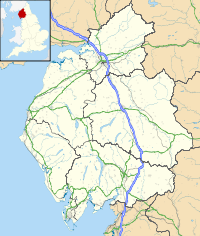- St Mary's Church, Ulverston
-
St Mary's Church, Ulverston 
Tower of St Mary's Church, UlverstonLocation in Cumbria Coordinates: 54°11′56″N 3°05′29″W / 54.1989°N 3.0915°W OS grid reference SD 290 787 Location Ulverston, Cumbria Country England Denomination Anglican Website St Mary, Ulverston Architecture Status Parish church Functional status Active Heritage designation Grade II* Designated 2 March 1950 Architect(s) E. G. Paley and successors (restorations) Architectural type Church Style Gothic, Gothic Revival Specifications Materials Sandstone and limestone, Slate roofs Administration Parish St Mary with Holy Trinity, Ulverston Deanery Furness Archdeaconry Westmoreland and Furness Diocese Carlisle Province York Clergy Rector Revd Canon Alan Bing Curate(s) Revd Andy Batchelor Laity Reader Julie Batchelor,
Janice Eadington,
Marilyn Fell,
Steve ParkinsonOrganist/Director of music Rachel Stanbrook Churchwarden(s) Sue Harries,
Keith HowsonParish administrator Joanna Pridmore St Mary's Church, Ulverston, stands in Church Walk in the town of Ulverston, Cumbria, England. It is an active Anglican parish church in the deanery of Furness, the archdeaconry of Westmoreland and Furness, and the diocese of Carlisle. Its benefice is united with those of St Jude, South Ulverston, and St John, Osmotherley.[1] The church has been designated by English Heritage as a Grade II* listed building.[2]
Contents
History
It is not known when the first church was built on the site. The tower of the present church was built between 1540 and 1560, replacing an earlier church which, it is said, was damaged when its steeple fell following a storm, damaging the rest if the building.[3] The church was restored and enlarged in 1804. It was extensively extensively restored and partly rebuilt between 1864 and 1868 under the direction of the Lancaster architect E. G. Paley.[2] This included the rebuilding of the aisle walls.[4] The successors in Paley's practice added a new transept, and carried out work on the chancel and windows in 1905.[5] The same firm converted the south chancel aisle into a war memorial in 1923.[4] The interior of the church was reordered in 2008–09; this included the provision of a refreshment and meeting area.[3]
Architecture
Exterior
The church is constructed in sandstone and limestone rubble with red sandstone dressings and slate roofs. Its plan consists of seven-bay nave with a clerestory, north and south aisles, a south porch, a chancel, and a west tower. The tower, dating from the 16th century, is in three stages, with buttresses at the angles, and an embattled parapet. It contains a west doorway, above which is a three-light window containing Perpendicular-style tracery. The bell openings have three lights, are louvred and have hoodmoulds. The north wall of the nave contains pointed windows with Perpendicular tracery, all with two lights, other than the western window, which has three lights. The west window has five lights. The windows in the clerestory have flat heads and three lights, and are mullioned. The south wall contains a priest's door, with four windows to its left and two to the right; all have two lights. The porch is gabled and has a cross finial. The east window in the chancel has five lights.[2] The inner doorway dates from the 12th century, it is in Norman style, and has zigzag decoration. Hyde and Pevsner state that it is neither complete, nor is it in its original position.[4]
Interior
The arcades are in seven bays and are carried on octagonal piers. The chancel is above the level of the nave, and is divided from it by a low sandstone wall pierced by quatrefoils. In the chancel is a double sedilia and a piscina. The choir stalls are in carved oak, and oak screens divide the chancel from the organ chamber and vestry to the north, and from the chapel to the south.[2] The three-manual organ replaced an earlier instrument built in 1866 by Thomas Wilkinson.[6] This was built by Thomas Pendlebury for a church elsewhere, and was installed in St Mary's in 1972.[7] The stained glass in the east window is by William Wailes, and windows elsewhere are by Heaton, Butler and Bayne. The church contains a number of monuments, the oldest, erected in 1588, is to William Sandys, who died in 1559.[4] The ring consists of six bells, all cast in 1836 by Thomas Mears II of the Whitechapel Bell Foundry.[8]
See also
- List of ecclesiastical works by E. G. Paley
- List of ecclesiastical works by Paley and Austin
- List of ecclesiastical works by Austin and Paley (1895–1914)
- List of ecclesiastical works by Austin and Paley (1916–44)
References
- ^ Ulverston: St Mary w Holy Trinity, Ulverston, Church of England, http://www.achurchnearyou.com/ulverston-st-mary-holy-trinity/, retrieved 13 July 2011
- ^ a b c d "Church of St Mary, Ulverston", The National Heritage List for England (English Heritage), 2011, http://list.english-heritage.org.uk/resultsingle.aspx?uid=1374977, retrieved 13 July 2011
- ^ a b History, Ulverston Parish, http://www.ulverstonparishchurch.org.uk/parish-church.html, retrieved 13 July 2011
- ^ a b c d Hyde, Matthew; Pevsner, Nikolaus (2010) [1967], Cumbria, The Buildings of England, New Haven and London: Yale University Press, pp. 647–649, ISBN 978-0-300-12663-1
- ^ Price, James (1998), Sharpe, Paley and Austin: A Lancaster Architectural Practice 1836–1942, Lancaster: Centre for North-West Regional Studies, pp. 250–251, ISBN 1-86220-054-8
- ^ Lancashire (Cumbria), Ulverston, St. Mary the Virgin, Church Walk (N10763), British Institute of Organ Studies, http://www.npor.org.uk/cgi-bin/Rsearch.cgi?Fn=Rsearch&rec_index=N10763, retrieved 13 July 2011
- ^ Lancashire (Cumbria), Ulverston, St. Mary the Virgin, Church Walk (N10762), British Institute of Organ Studies, http://www.npor.org.uk/cgi-bin/Rsearch.cgi?Fn=Rsearch&rec_index=N10762, retrieved 13 July 2011
- ^ Ulverston, S Mary V, Dove's Guide for Church Bell Ringers, http://dove.cccbr.org.uk/detail.php?searchString=ulverston&Submit=+Go+&DoveID=ULVERSTON, retrieved 13 July 2011
Categories:- Church of England churches in Cumbria
- Diocese of Carlisle
- Grade II* listed churches
- Grade II* listed buildings in Cumbria
- Norman architecture
- English Gothic architecture
- Gothic Revival architecture in Cumbria
- E. G. Paley buildings
- Paley and Austin buildings
- Austin and Paley buildings
Wikimedia Foundation. 2010.

